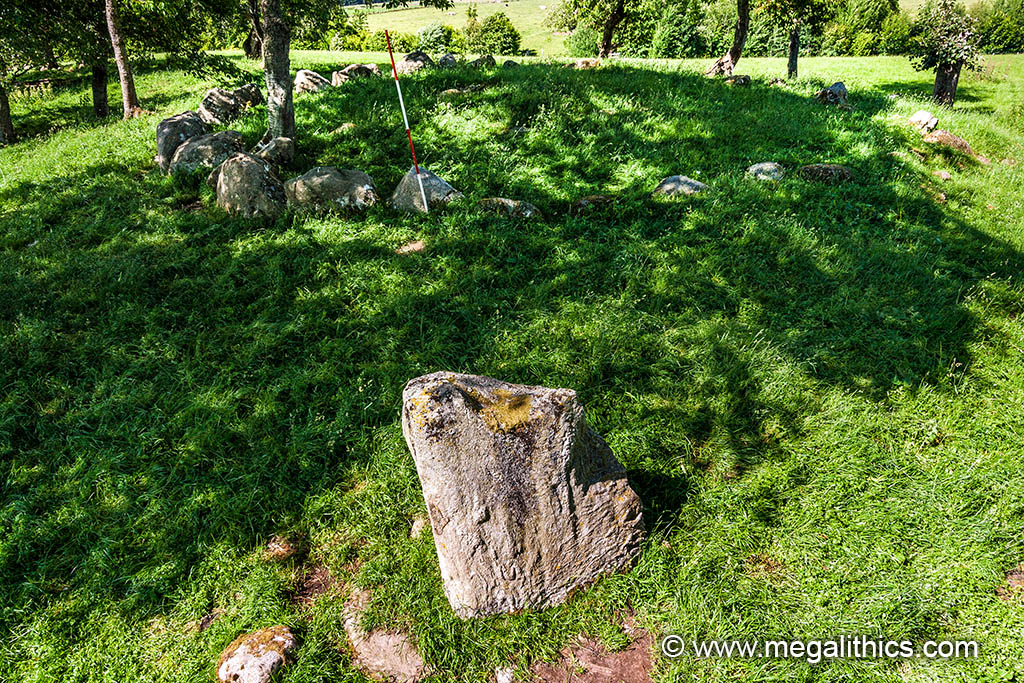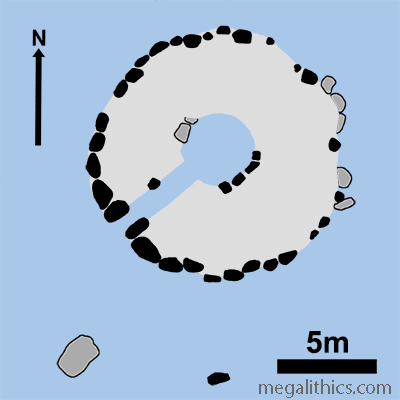 |
| NH 77981 48460 (GPS 17min) Largest inner kerb stone | Diameter - 12.2m Outer kerb (meas.), 21.7m Stone Circle (Est.) |
| Visited June 2010 | Alt.131m OD (GPS) |
 |
Dalcross Mains ( INV 26 ), also known as Castle Dalcross, is a Clava Ring-Cairn in a reasonable state of preservation. The cairn is situated about 6km Northeast of Culloden on a low ridge that has been transformed into a hillock by ploughing and quarrying to its sides. The Moray Firth is only 6km away to the NW and a good length of this is visible from the site (or would be, if it weren't for the trees!).

PUBLISHED ACCOUNTS
There is very little coverage in the
early literature regarding Dalcross Mains. Fraser
(1)
includes it in his 1884 survey of the Inverness area "Druidical Circles", but
apart from an entry in his list with the comment "fragmentary" (which is
surprising given what can be seen there today) he gives no other details. Piggot
(2)
also lists the site in his survey of Clava monuments, and he does identify it as
a Clava Passage Grave, but apart from including a plan of the site, and
mentioning this is the first to be published, gives no further details.
It is not until 1963 and the publication of Henshall's opus
(3)
that any real description of the monument's structure appears. The Thoms and
Burl (4)
plan the site in their work of 1980 and provide another brief
description. Their plan however, does not show any of the existing passage or
chamber wall stones. It is not until Henshall and Ritchie's
(5)
most excellent work on the Central Highland cairns in 2001
that a detailed account of the monument is made available.
We could find no reference of any excavations at the site in any of the above works, and presume it is still unexcavated, although the current presentation, and the exposure of many low stones would suggest otherwise.
THE CAIRN STRUCTURE
The cairn is situated on a low ridge amongst trees, indeed some are growing in the interior! The tree trunks and their foliage made photographing the monument a difficult task, especially as one particular tree had decided to grow exactly in the centre of the entrance passage, just behind the portal stones. The vast majority of the cairn fill has been robbed away in antiquity, as have nearly all of the passage, central chamber walling and roofing stones. If it were not for the obvious opening and portal stones let into the kerb, one could easily mistake this monument for a Clava Ring-Cairn.
The outer kerb stones enclose a diameter of 12.2m and are almost intact in the southwestern half of the circle, they are also mostly present, but displaced, in the eastern half. The kerb stones are taller and more massive in the SW arc either side of the entrance, and much smaller in the eastern arc, a typical Clava trait. The entrance is flanked by two large kerbs turned 90 degrees and set radially, these stones are framed by the two tallest and biggest stones in the kerb, both having very flat outer faces. The entrance gap is about 0.58m wide but the width of the original passage is unknown as only one stone from its walling exists, at the North. Similarly, very few walling stones of the chamber remain, there is a large displaced stone and a partially buried one visible from the NW walling, and an arc of four almost buried stones at the SE. The original chamber diameter seems to have been around 3.4m, but there are no indications remaining of what roofing structure the intact monument had.
The cairn was surrounded by a free standing stone circle of which only two stones remain. There is an erect stone at the South which stands 1.35m tall, although this was probably taller as upper section appears to have broken off. The second stone lies fallen at the SSW, this is a large slab about 2m long bearing quartzite veins. Assuming the fallen stone has not been moved, we plotted a circle of 22.6m using the position of this and the erect stone, the current spacing would suggest an 11 to 12 stone ring. These figures are a massive extrapolation from scant data, but given the quarrying that has occurred very close to the cairn on two sides, it is doubtful that an excavation would find all of the stone holes.
Apart from the sparse chamber remains, the cairn is in a good state of preservation and strong evidence for most of the original structure remains. There are no extraneous confusing elements such as the field clearance dumping, or dumping of broken up circle stones seen at Cullearnie, so it is easy to visualise the likely original form of the monument during a visit.
1. Fraser J.,
Proceedings of the Society of Antiquaries of
Scotland, 18, p.328-61,1884.
2.
Piggott, S., Proceedings of the Society of Antiquaries of
Scotland, 88, p.173-207,1956.
3.
Henshall, A. S.,
The Chambered Cairns of Scotland,
p.374, Edinburgh University Press, 1963,
Edinburgh.
4.
Thom, A., Thom, A. S. and Burl, A., Megalithic
Rings, B.A.R. British Series, 81, 1980, Oxford.
5.
Henshall, A. S. and Ritchie J. N. G., The Chambered
Cairns of the Central Highlands, p.217-8,
Edinburgh University Press, 2001, Edinburgh.